Upscaling of Soil Moisture over Highly Heterogeneous Surfaces and Validation of SMAP Product
Abstract
1. Introduction
2. Materials and Methods
2.1. Study Area
2.2. Research Data
2.2.1. In Situ Data
2.2.2. HLS Data
2.2.3. DEM Data
2.2.4. SMAP SM Product
2.3. Methods
2.3.1. Data Processing
2.3.2. Assessment of Spatial Heterogeneity
2.3.3. Machine Learning Models
2.3.4. Evaluation Metrics
2.3.5. SHapley Additive exPlanations (SHAP)
3. Results
3.1. Monitoring During the Unfrozen Period
3.2. Evaluation of Upscaling Framework
3.3. SHAP
3.4. SMAP Validation
3.4.1. Validation of SPL3SMP
3.4.2. Validation of SPL3SMP_E
4. Discussion
- Paying attention to spectral mixing effects in optical remote sensing and exploring novel spectral unmixing algorithms in future studies to more accurately separate signals from vegetation, bare soil, and dry/dead vegetation, thereby improving soil moisture estimation in mixed pixels [56].
5. Conclusions
- A diverse set of predictor variables was constructed from high-spatiotemporal-resolution HLS v2.0 data. When integrated with in situ measurements, these variables enabled multiple machine learning models to upscale soil moisture at a 30 m resolution, capturing significant fine-scale spatial heterogeneity within the study area.
- Among all models, XGBoost offered the highest predictive accuracy on the independent test set (R = 0.941, RMSE = 0.047 m3·m−3). The model’s strong performance is likely attributable to its ability to capture the complex, nonlinear relationships driven by factors such as elevation and seasonal dynamics (DOY).
- The high-resolution soil moisture product upscaled by the XGBoost model served as an effective pixel-scale validation reference. Its application helped mitigate errors from scale mismatch and spatial representativeness, improving the correlation with the 36 km SMAP product from R = 0.818 (using traditional in situ averaging) to R = 0.858.
- The validation provided further insights into SMAP’s performance in this region. Descending-orbit data generally yielded higher accuracy than ascending-orbit data, with only the 36 km descending-orbit product approaching the scientific standard. Moreover, the assessment of the 9 km product revealed a strong negative correlation between SMAP’s accuracy and terrain heterogeneity, highlighting potential challenges for the product in complex mountain environments.
Author Contributions
Funding
Data Availability Statement
Conflicts of Interest
References
- Dubois, P.C.; Van Zyl, J.; Engman, T. Measuring Soil Moisture with Imaging Radars. IEEE Trans. Geosci. Remote Sens. 1995, 33, 915–926. [Google Scholar] [CrossRef]
- Walker, J.; Rowntree, P.R. The Effect of Soil Moisture on Circulation and Rainfall in a Tropical Model. Quart. J. Royal Meteorol. Soc. 1977, 103, 29–46. [Google Scholar] [CrossRef]
- Wood, E.F. Effects of Soil Moisture Aggregation on Surface Evaporative Fluxes. J. Hydrol. 1997, 190, 397–412. [Google Scholar] [CrossRef]
- McColl, K.A.; Alemohammad, S.H.; Akbar, R.; Konings, A.G.; Yueh, S.; Entekhabi, D. The Global Distribution and Dynamics of Surface Soil Moisture. Nat. Geosci. 2017, 10, 100–104. [Google Scholar] [CrossRef]
- Njoku, E.G.; Li, L. Retrieval of Land Surface Parameters Using Passive Microwave Measurements at 6-18 GHz. IEEE Trans. Geosci. Remote Sens. 1999, 37, 79–93. [Google Scholar] [CrossRef]
- Owe, M.; De Jeu, R.; Holmes, T. Multisensor Historical Climatology of Satellite-derived Global Land Surface Moisture. J. Geophys. Res. 2008, 113, F01002. [Google Scholar] [CrossRef]
- Koike, T.; Nakamura, Y.; Kaihotsu, I.; Davaa, G.; Matsuura, N.; Tamagawa, K.; Fujii, H. Development of an advanced microwave scanning radiometer (amsr-e) algorithm for soil moisture and vegetation water content. Proc. Hydraul. Eng. 2004, 48, 217–222. [Google Scholar] [CrossRef]
- Kerr, Y.H.; Waldteufel, P.; Wigneron, J.-P.; Delwart, S.; Cabot, F.; Boutin, J.; Escorihuela, M.-J.; Font, J.; Reul, N.; Gruhier, C.; et al. The SMOS Mission: New Tool for Monitoring Key Elements Ofthe Global Water Cycle. Proc. IEEE 2010, 98, 666–687. [Google Scholar] [CrossRef]
- Brocca, L.; Hasenauer, S.; Lacava, T.; Melone, F.; Moramarco, T.; Wagner, W.; Dorigo, W.; Matgen, P.; Martínez-Fernández, J.; Llorens, P.; et al. Soil Moisture Estimation through ASCAT and AMSR-E Sensors: An Intercomparison and Validation Study across Europe. Remote Sens. Environ. 2011, 115, 3390–3408. [Google Scholar] [CrossRef]
- Zhao, L.; Yang, K.; Qin, J.; Chen, Y.; Tang, W.; Montzka, C.; Wu, H.; Lin, C.; Han, M.; Vereecken, H. Spatiotemporal Analysis of Soil Moisture Observations within a Tibetan Mesoscale Area and Its Implication to Regional Soil Moisture Measurements. J. Hydrol. 2013, 482, 92–104. [Google Scholar] [CrossRef]
- Loew, A.; Schlenz, F. A Dynamic Approach for Evaluating Coarse Scale Satellite Soil Moisture Products. Hydrol. Earth Syst. Sci. 2011, 15, 75–90. [Google Scholar] [CrossRef]
- Kang, J.; Jin, R.; Li, X. Regression Kriging-Based Upscaling of Soil Moisture Measurements From a Wireless Sensor Network and Multiresource Remote Sensing Information Over Heterogeneous Cropland. IEEE Geosci. Remote Sens. Lett. 2015, 12, 92–96. [Google Scholar] [CrossRef]
- Wang, J.; Ge, Y.; Song, Y.; Li, X. A Geostatistical Approach to Upscale Soil Moisture With Unequal Precision Observations. IEEE Geosci. Remote Sens. Lett. 2014, 11, 2125–2129. [Google Scholar] [CrossRef]
- Qin, J.; Yang, K.; Lu, N.; Chen, Y.; Zhao, L.; Han, M. Spatial Upscaling of In-Situ Soil Moisture Measurements Based on MODIS-Derived Apparent Thermal Inertia. Remote Sens. Environ. 2013, 138, 1–9. [Google Scholar] [CrossRef]
- Chen, J.; Hu, F.; Li, J.; Xie, Y.; Zhang, W.; Huang, C.; Meng, L. Evaluation of SMAP-Enhanced Products Using Upscaled Soil Moisture Data Based on Random Forest Regression: A Case Study of the Qinghai–Tibet Plateau, China. ISPRS Int. J. Geo-Inf. 2023, 12, 281. [Google Scholar] [CrossRef]
- Xu, J.; Su, Q.; Li, X.; Ma, J.; Song, W.; Zhang, L.; Su, X. A Spatial Downscaling Framework for SMAP Soil Moisture Based on Stacking Strategy. Remote Sens. 2024, 16, 200. [Google Scholar] [CrossRef]
- Long, D.; Bai, L.; Yan, L.; Zhang, C.; Yang, W.; Lei, H.; Quan, J.; Meng, X.; Shi, C. Generation of Spatially Complete and Daily Continuous Surface Soil Moisture of High Spatial Resolution. Remote Sens. Environ. 2019, 233, 111364. [Google Scholar] [CrossRef]
- Zheng, G.; Zhao, T.; Liu, Y. Cloud Removal in the Tibetan Plateau Region Based on Self-Attention and Local-Attention Models. Sensors 2024, 24, 7848. [Google Scholar] [CrossRef]
- Chrysanthopoulos, E.; Kallioras, A. Temporal and Geographic Extrapolation of Soil Moisture Using Machine Learning Algorithms. CATENA 2025, 257, 109156. [Google Scholar] [CrossRef]
- Ju, J.; Zhou, Q.; Freitag, B.; Roy, D.P.; Zhang, H.K.; Sridhar, M.; Mandel, J.; Arab, S.; Schmidt, G.; Crawford, C.J.; et al. The Harmonized Landsat and Sentinel-2 Version 2.0 Surface Reflectance Dataset. Remote Sens. Environ. 2025, 324, 114723. [Google Scholar] [CrossRef]
- Roy, D.; Ghosh, T.; Das, B.; Jatav, R.; Chakraborty, D. Smartphone-Based Image Analysis and Interpretable Machine Learning for Soil Moisture Estimation across Diverse Indian Soils. Remote Sens. Appl. Soc. Environ. 2025, 39, 101655. [Google Scholar] [CrossRef]
- Bayable, G.; Gebrie, G.; Melese, T.; Melaku, A. Land Use/Cover Classification Using Machine Learning Algorithms and Their Impacts on Land Surface Temperature and Soil Moisture in the Alawuha Watershed, Ethiopia. Environ. Sustain. Indic. 2025, 27, 100797. [Google Scholar] [CrossRef]
- Chai, L.; Zhu, Z.; Liu, S.; Xu, Z.; Jin, R.; Li, X.; Kang, J.; Che, T.; Zhang, Y.; Zhang, J.; et al. QLB-NET: A Dense Soil Moisture and Freeze–Thaw Monitoring Network in the Qinghai Lake Basin on the Qinghai–Tibetan Plateau. Bull. Am. Meteorol. Soc. 2024, 105, 584–604. [Google Scholar] [CrossRef]
- Uuemaa, E.; Ahi, S.; Montibeller, B.; Muru, M.; Kmoch, A. Vertical Accuracy of Freely Available Global Digital Elevation Models (ASTER, AW3D30, MERIT, TanDEM-X, SRTM, and NASADEM). Remote Sens. 2020, 12, 3482. [Google Scholar] [CrossRef]
- Zhang, R.; Kim, S.; Sharma, A. A Comprehensive Validation of the SMAP Enhanced Level-3 Soil Moisture Product Using Ground Measurements over Varied Climates and Landscapes. Remote Sens. Environ. 2019, 223, 82–94. [Google Scholar] [CrossRef]
- González-Ramírez, A.; Atzberger, C.; Torres-Roman, D.; López, J. Representation Learning of Multi-Spectral Earth Observation Time Series and Evaluation for Crop Type Classification. Remote Sens. 2025, 17, 378. [Google Scholar] [CrossRef]
- Zhu, L.; Dai, J.; Liu, Y.; Yuan, S.; Qin, T.; Walker, J.P. A Cross-Resolution Transfer Learning Approach for Soil Moisture Retrieval from Sentinel-1 Using Limited Training Samples. Remote Sens. Environ. 2024, 301, 113944. [Google Scholar] [CrossRef]
- Pedregosa, F.; Varoquaux, G.; Org, N.; Gramfort, A.; Gramfort, A.; Michel, V.; Michel, V.; Fr, L.; Thirion, B.; Thirion, B.; et al. Scikit-Learn: Machine Learning in Python. J. Mach. Learn. Res. 2011, 12, 2825–2830. [Google Scholar]
- Zhou, Z.; Sun, O.J.; Luo, Z.; Jin, H.; Chen, Q.; Han, X. Variation in Small-Scale Spatial Heterogeneity of Soil Properties and Vegetation with Different Land Use in Semiarid Grassland Ecosystem. Plant Soil. 2008, 310, 103–112. [Google Scholar] [CrossRef]
- Breiman, L. Random Forests. Mach. Learn. 2001, 45, 5–32. [Google Scholar] [CrossRef]
- Geurts, P.; Ernst, D.; Wehenkel, L. Extremely Randomized Trees. Mach. Learn. 2006, 63, 3–42. [Google Scholar] [CrossRef]
- Chen, T.; Guestrin, C. XGBoost: A Scalable Tree Boosting System. In Proceedings of the 22nd ACM Sigkdd International Conference on Knowledge Discovery and Data Mining, San Francisco, CA, USA, 13–17 August 2016. [Google Scholar] [CrossRef]
- Prokhorenkova, L.; Gusev, G.; Vorobev, A.; Dorogush, A.V.; Gulin, A. CatBoost: Unbiased Boosting with Categorical Features. In Proceedings of the Advances in Neural Information Processing Systems, San Diego, CA, USA, 2–8 December 2018; Volume 31. [Google Scholar]
- Friedman, J.H. Greedy Function Approximation: A Gradient Boosting Machine. Ann. Stat. 2001, 29, 1189–1232. [Google Scholar] [CrossRef]
- Lundberg, S.; Lee, S.-I. A Unified Approach to Interpreting Model Predictions. In Proceedings of the Advances in Neural Information Processing Systems 30, Long Beach, CA, USA, 4–9 December 2017; Volume 30. [Google Scholar]
- Pradhan, B.; Dikshit, A.; Lee, S.; Kim, H. An Explainable AI (XAI) Model for Landslide Susceptibility Modeling. Appl. Soft Comput. 2023, 142, 110324. [Google Scholar] [CrossRef]
- Zhang, H. Hyperspectral Response Characteristics and Monitor on Soil Water. Crops 2023, 1, 233–238. [Google Scholar] [CrossRef]
- Chan, S.; Bindlish, R.; Chaubell, M.; Colliander, A.; Chen, F.; Dunbar, S.; Jackson, T.; Cosh, M.; Bongiovanni, T.; Walker, J.; et al. Soil Moisture Active Passive (SMAP) Project: Calibration and Validation for the L2/3_SM_P Version 7 and L2/3_SM_P_E Version 4 Data Products; National Snow and Ice Data Center: Boulder, CO, USA, 2020. [Google Scholar]
- Chen, Y.; Yang, K.; Qin, J.; Cui, Q.; Lu, H.; La, Z.; Han, M.; Tang, W. Evaluation of SMAP, SMOS, and AMSR2 Soil Moisture Retrievals against Observations from Two Networks on the Tibetan Plateau. JGR Atmos. 2017, 122, 5780–5792. [Google Scholar] [CrossRef]
- Wu, Q.; Zhu, Z.; Ma, J.; Liu, S.; Chai, L.; Xu, Z. Soil Moisture Retrieval Based on Ensemble Learning Models Using Landsat8 Data in Areas of High Heterogeneity. ResearchGate 2024, in press. [Google Scholar] [CrossRef]
- Shangguan, Y.; Min, X.; Shi, Z. Inter-Comparison and Integration of Different Soil Moisture Downscaling Methods over the Qinghai-Tibet Plateau. J. Hydrol. 2023, 617, 129014. [Google Scholar] [CrossRef]
- Duan, X.; Maqsoom, A.; Khalil, U.; Aslam, B.; Amjad, T.; Tufail, R.F.; Alarifi, S.S.; Tariq, A. Enhancing Soil Moisture Retrieval in Semi-Arid Regions Using Machine Learning Algorithms and Remote Sensing Data. Appl. Soil. Ecol. 2024, 204, 105687. [Google Scholar] [CrossRef]
- Burchard-Levine, V.; Nieto, H.; Riaño, D.; Migliavacca, M.; El-Madany, T.S.; Guzinski, R.; Carrara, A.; Martín, M.P. The Effect of Pixel Heterogeneity for Remote Sensing Based Retrievals of Evapotranspiration in a Semi-Arid Tree-Grass Ecosystem. Remote Sens. Environ. 2021, 260, 112440. [Google Scholar] [CrossRef]
- Shen, M.; Tang, Y.; Chen, J.; Zhu, X.; Zheng, Y. Influences of Temperature and Precipitation before the Growing Season on Spring Phenology in Grasslands of the Central and Eastern Qinghai-Tibetan Plateau. Agric. For. Meteorol. 2011, 151, 1711–1722. [Google Scholar] [CrossRef]
- Helman, D. Land Surface Phenology: What Do We Really ‘See’ from Space? Sci. Total Environ. 2018, 618, 665–673. [Google Scholar] [CrossRef] [PubMed]
- He, L.; He, Z.; Chen, X.; Li, L.; Wu, W.; Kang, G.; Gong, J. Metallogenic Prediction Based on Multi-Source Remote Sensing and Machine Learning: A Case of Lithium Ore in Jiajika, China. Ore Geol. Rev. 2025, 185, 106813. [Google Scholar] [CrossRef]
- Garcia-Prats, A.; Carricondo-Antón, J.M.; Ippolito, M.; De Caro, D.; Jiménez-Bello, M.A.; Manzano-Juárez, J.; Pulido-Velazquez, M. High-Resolution Spatially Interpolated FAO Penman-Monteith Crop Reference Evapotranspiration Maps of Sicily Island (Italy) and Jucar River System (Spain) Using AgERA5 and ERA5-Land Reanalysis Datasets. J. Hydrol. Reg. Stud. 2025, 60, 102531. [Google Scholar] [CrossRef] [PubMed]
- Majidi, F.; Sabetghadam, S.; Gharaylou, M.; Rezaian, R. Evaluation of the Performance of ERA5, ERA5-Land and MERRA-2 Reanalysis to Estimate Snow Depth over a Mountainous Semi-Arid Region in Iran. J. Hydrol. Reg. Stud. 2025, 58, 102246. [Google Scholar] [CrossRef]
- Fang, Z.; Qu, S.; Li, Z.; Li, Q.; Shi, P.; Sun, Y.; Yang, X.; Tang, H.; Zhang, J.; Zhu, Z.; et al. Soil Water Accounting Network (SWAN): A Novel Neural Network for Modeling Conceptual Hydrological Processes. J. Hydrol. 2025, 661, 133562. [Google Scholar] [CrossRef]
- Fang, Q. Decoupling Climate and Vegetation Impacts on Hydrological Processes in Semi-Arid Regions Using an Improved Grid-Scale Budyko Model. J. Hydrol. Reg. Stud. 2025, 61, 102691. [Google Scholar] [CrossRef]
- Zhao, C.; Guan, C.; Yu, T.; Wang, J.; Li, H.; Wang, X.; Zhang, B.; Kou, S.; Liu, X.; Zhao, C. Feasibility of Planting Shrubs in Arid Areas from a Water Balance Perspective. J. Hydrol. 2025, 661, 133753. [Google Scholar] [CrossRef]
- Bai, X.; Fan, S.; Li, R.; Dai, T.; Li, W.; Ye, S.; Qian, L.; Liu, L.; Zhang, Z.; Chen, H.; et al. Estimating Root Zone Soil Moisture in Farmland by Integrating Multi-Source Remote Sensing Data Based on the Water Balance Equation. Agric. Water Manag. 2025, 314, 109544. [Google Scholar] [CrossRef]
- Min, X.; Shangguan, Y.; Li, D.; Shi, Z. Improving the Fusion of Global Soil Moisture Datasets from SMAP, SMOS, ASCAT, and MERRA2 by Considering the Non-Zero Error Covariance. Int. J. Appl. Earth Obs. Geoinf. 2022, 113, 103016. [Google Scholar] [CrossRef]
- Kim, H.; Crow, W.; Li, X.; Wagner, W.; Hahn, S.; Lakshmi, V. True Global Error Maps for SMAP, SMOS, and ASCAT Soil Moisture Data Based on Machine Learning and Triple Collocation Analysis. Remote Sens. Environ. 2023, 298, 113776. [Google Scholar] [CrossRef]
- Hu, F.; Wei, Z.; Yang, X.; Xie, W.; Li, Y.; Cui, C.; Yang, B.; Tao, C.; Zhang, W.; Meng, L. Assessment of SMAP and SMOS Soil Moisture Products Using Triple Collocation Method over Inner Mongolia. J. Hydrol. Reg. Stud. 2022, 40, 101027. [Google Scholar] [CrossRef]
- Chen, X.; Wang, D.; Chen, J.; Wang, C.; Shen, M. The Mixed Pixel Effect in Land Surface Phenology: A Simulation Study. Remote Sens. Environ. 2018, 211, 338–344. [Google Scholar] [CrossRef]


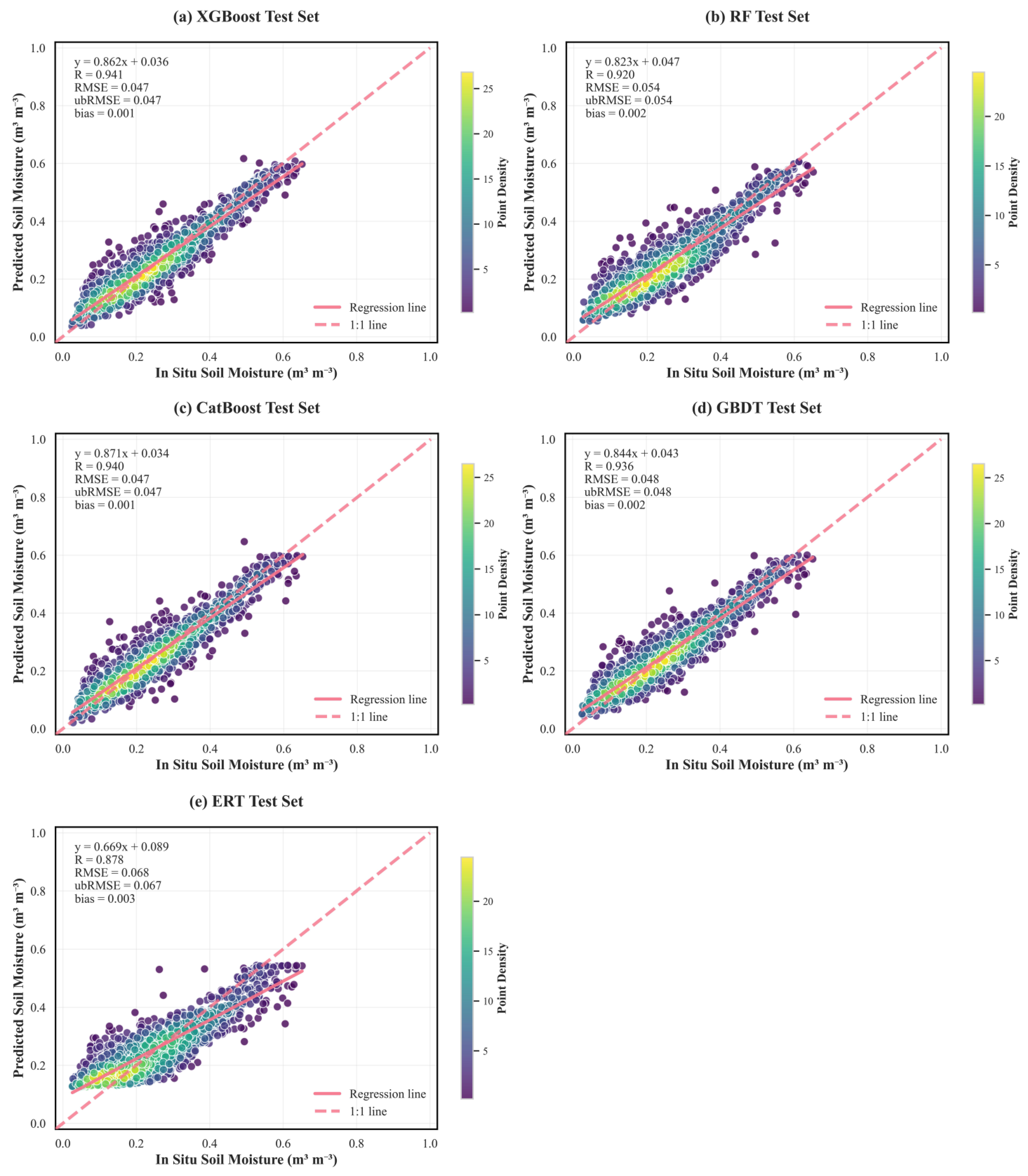
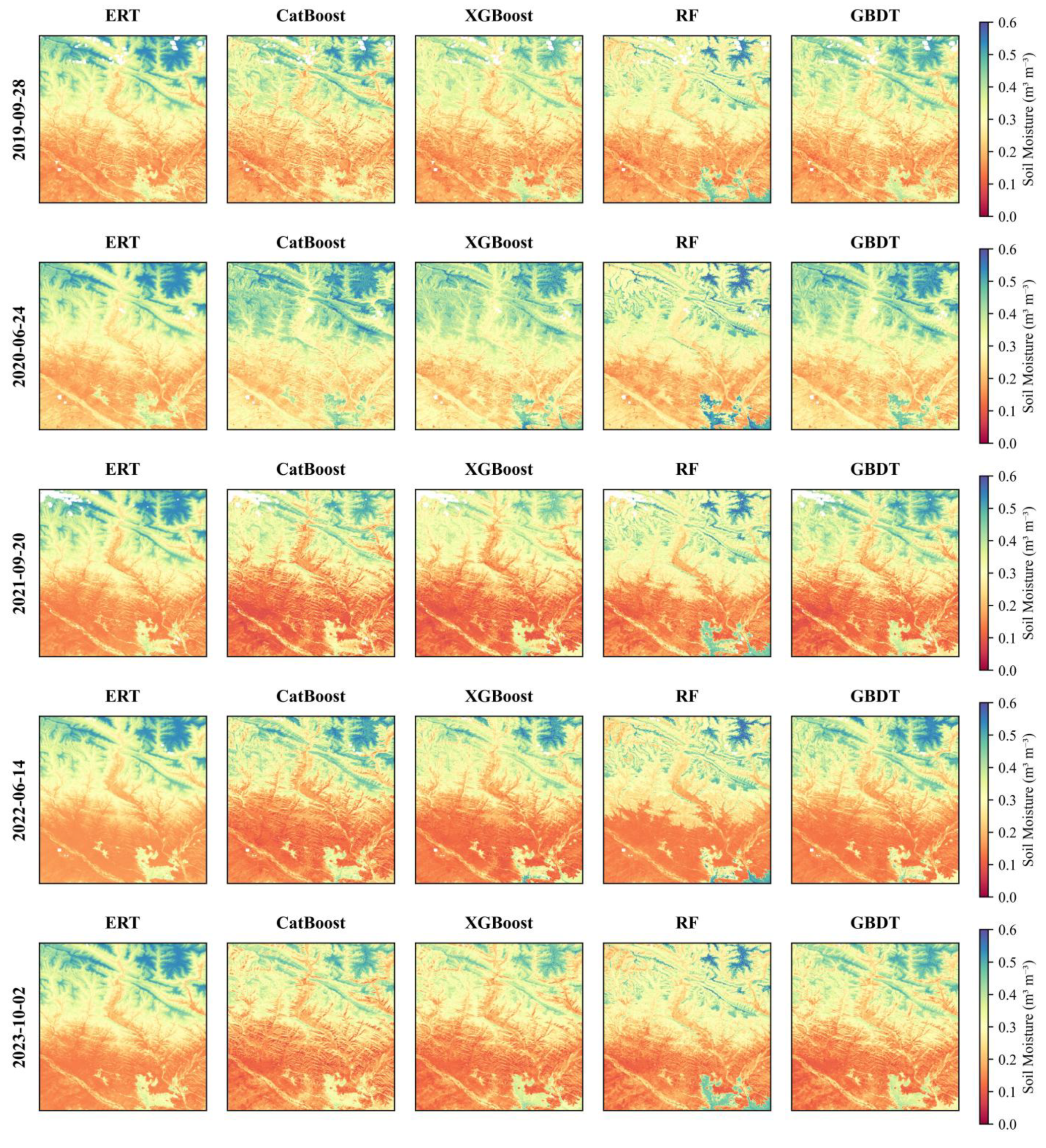
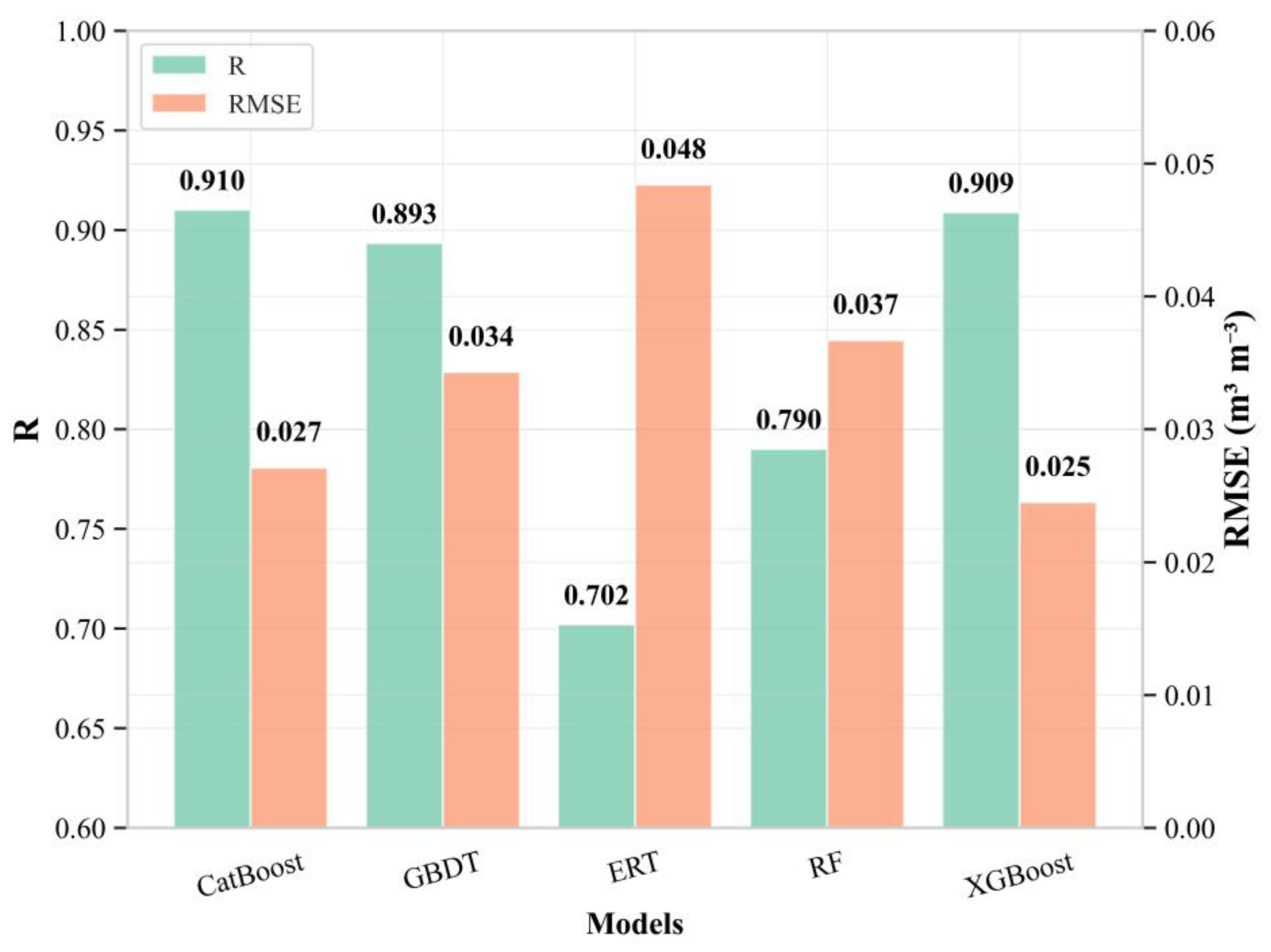

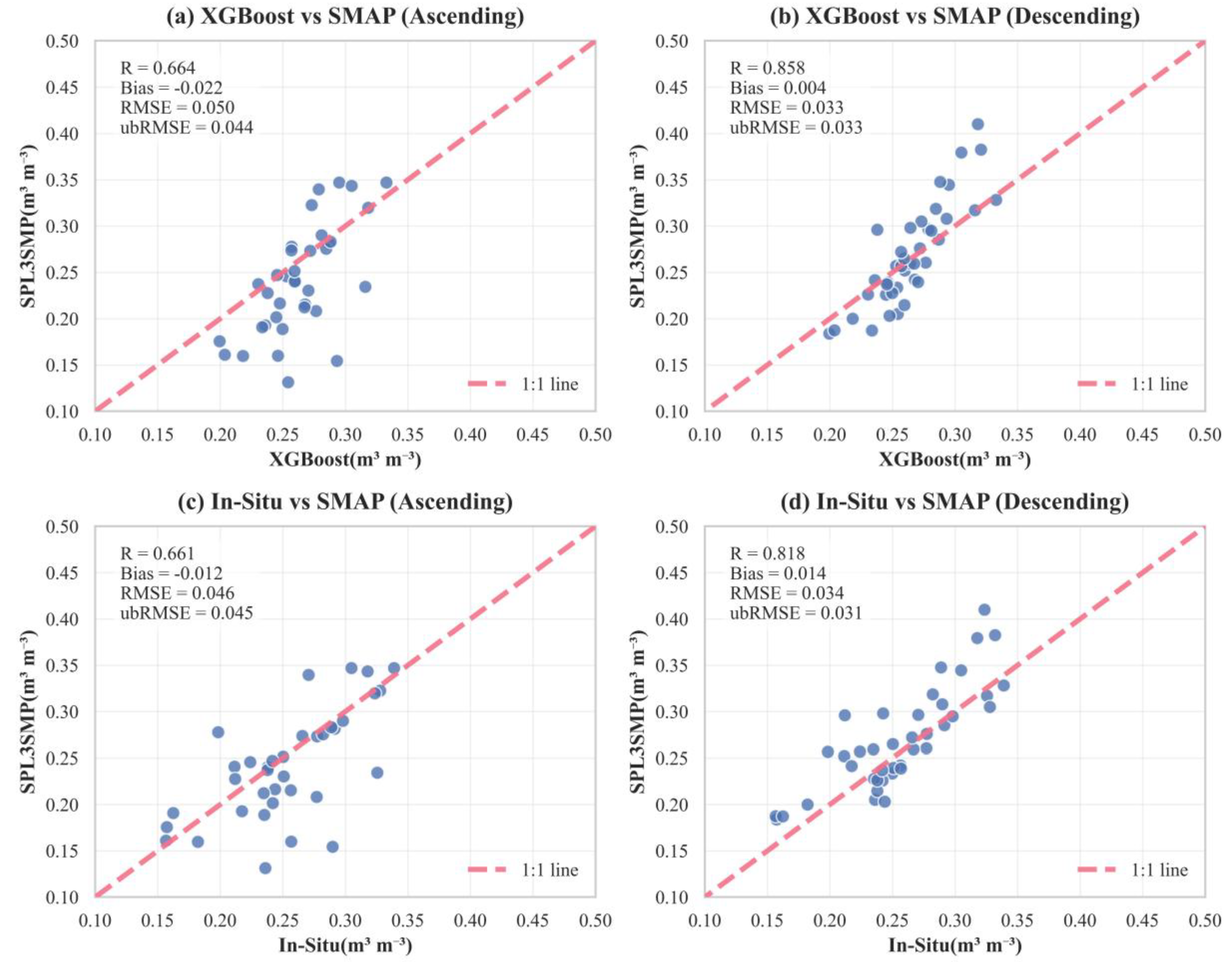
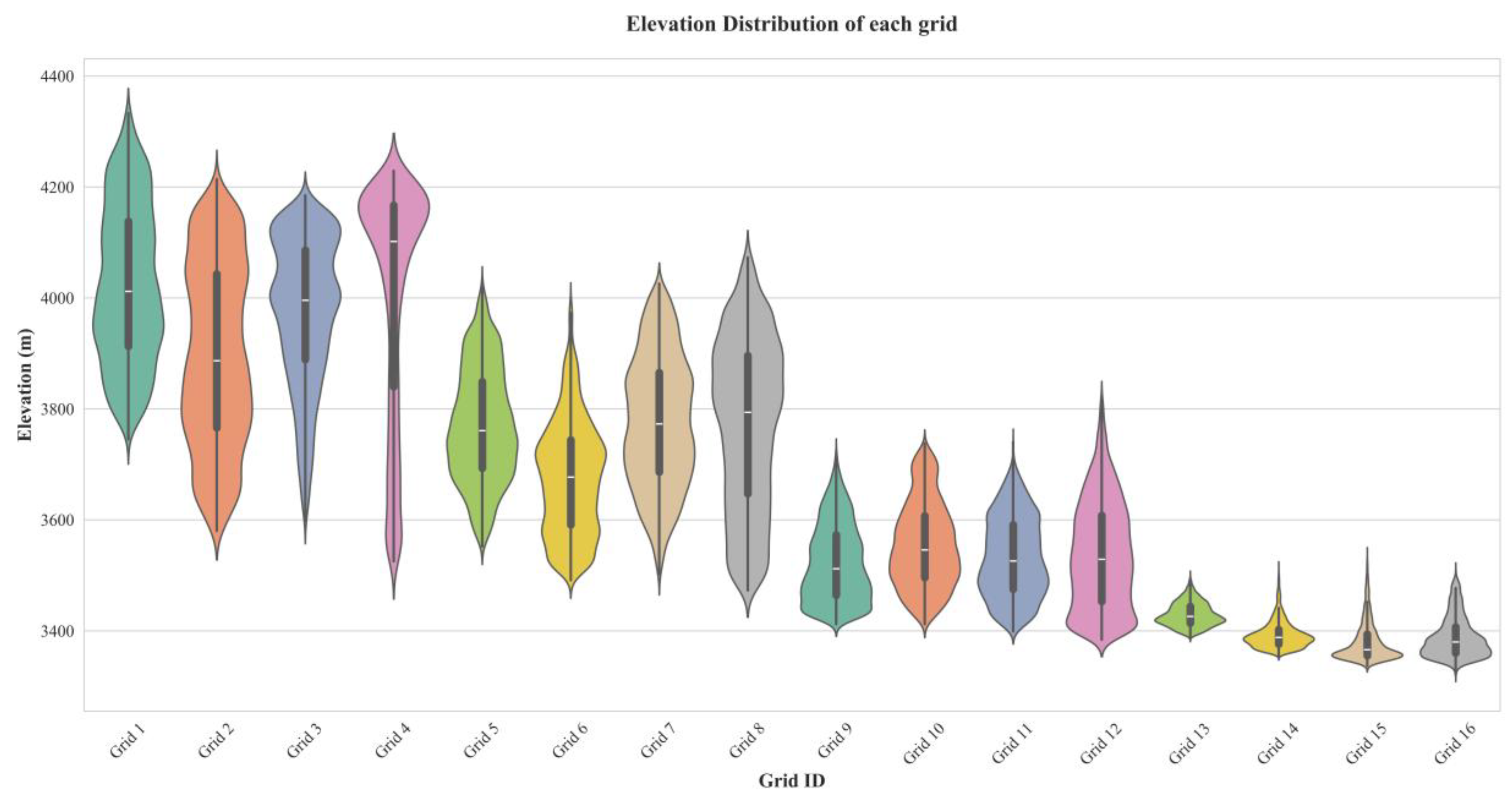
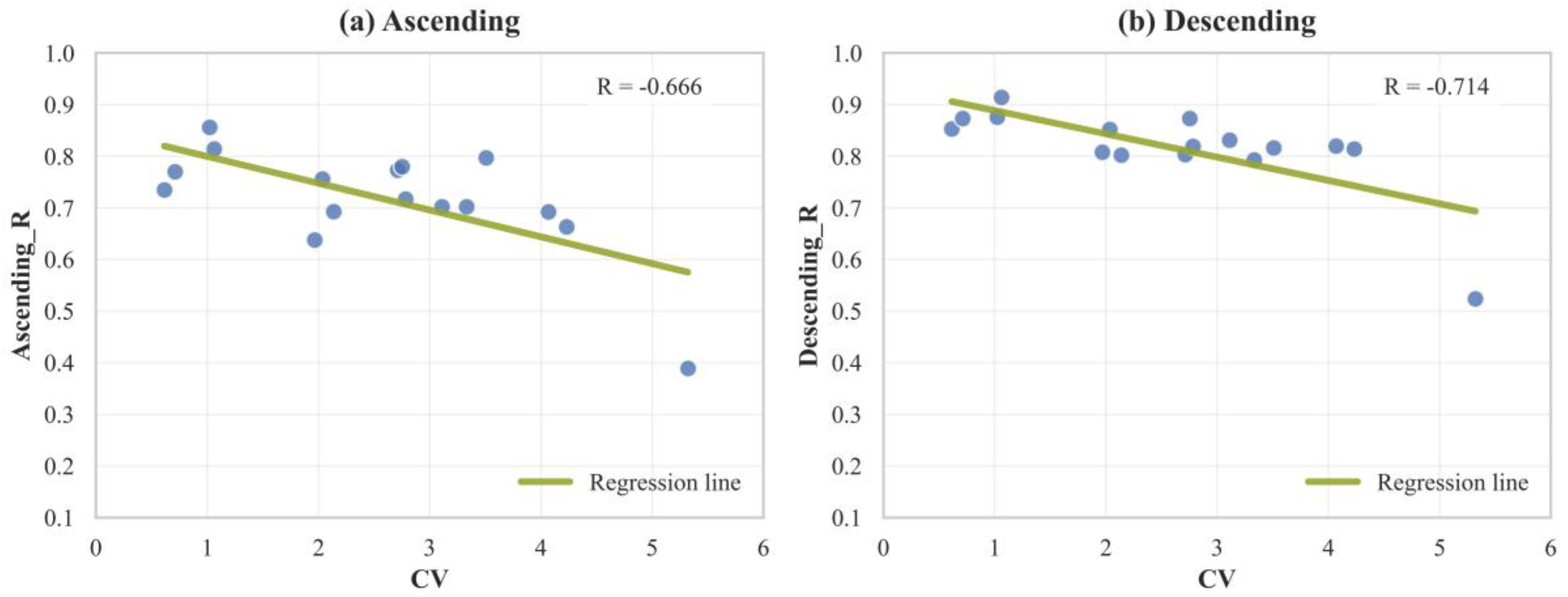

| Year | Start | End |
|---|---|---|
| 2019 | 09–03 | 10–15 |
| 2020 | 05–03 | 10–14 |
| 2021 | 05–13 | 10–13 |
| 2022 | 05–07 | 10–08 |
| 2023 | 05–03 | 10–18 |
| Model | R | RMSE (m3 m−3) |
|---|---|---|
| CatBoost | 0.910 | 0.027 |
| GBDT | 0.893 | 0.034 |
| ERT | 0.702 | 0.048 |
| RF | 0.790 | 0.037 |
| XGBoost | 0.909 | 0.025 |
| Grid ID | Ascending | Grid ID | Descending | ||||||
|---|---|---|---|---|---|---|---|---|---|
| R | Bias | RMSE | ubRMSE | R | Bias | RMSE | ubRMSE | ||
| 1 | 0.797 | −0.102 | 0.109 | 0.039 | 1 | 0.816 | −0.072 | 0.081 | 0.036 |
| 2 | 0.663 | −0.075 | 0.087 | 0.044 | 2 | 0.814 | −0.046 | 0.059 | 0.036 |
| 3 | 0.702 | −0.093 | 0.102 | 0.043 | 3 | 0.793 | −0.066 | 0.075 | 0.035 |
| 4 | 0.389 | −0.097 | 0.110 | 0.053 | 4 | 0.524 | −0.070 | 0.082 | 0.043 |
| 5 | 0.773 | −0.076 | 0.085 | 0.040 | 5 | 0.803 | −0.048 | 0.060 | 0.036 |
| 6 | 0.717 | −0.032 | 0.052 | 0.040 | 6 | 0.819 | −0.007 | 0.035 | 0.034 |
| 7 | 0.702 | −0.063 | 0.075 | 0.040 | 7 | 0.831 | −0.039 | 0.050 | 0.032 |
| 8 | 0.692 | −0.061 | 0.074 | 0.043 | 8 | 0.820 | −0.040 | 0.052 | 0.034 |
| 9 | 0.638 | 0.045 | 0.064 | 0.046 | 9 | 0.808 | 0.066 | 0.076 | 0.038 |
| 10 | 0.693 | 0.030 | 0.050 | 0.040 | 10 | 0.802 | 0.051 | 0.063 | 0.037 |
| 11 | 0.756 | 0.031 | 0.048 | 0.037 | 11 | 0.852 | 0.052 | 0.062 | 0.033 |
| 12 | 0.780 | 0.027 | 0.046 | 0.037 | 12 | 0.873 | 0.044 | 0.055 | 0.032 |
| 13 | 0.735 | 0.057 | 0.070 | 0.041 | 13 | 0.853 | 0.076 | 0.083 | 0.034 |
| 14 | 0.770 | 0.054 | 0.066 | 0.037 | 14 | 0.873 | 0.076 | 0.083 | 0.034 |
| 15 | 0.856 | 0.023 | 0.038 | 0.031 | 15 | 0.876 | 0.043 | 0.054 | 0.033 |
| 16 | 0.814 | 0.041 | 0.053 | 0.035 | 16 | 0.914 | 0.055 | 0.064 | 0.031 |
Disclaimer/Publisher’s Note: The statements, opinions and data contained in all publications are solely those of the individual author(s) and contributor(s) and not of MDPI and/or the editor(s). MDPI and/or the editor(s) disclaim responsibility for any injury to people or property resulting from any ideas, methods, instructions or products referred to in the content. |
© 2025 by the authors. Licensee MDPI, Basel, Switzerland. This article is an open access article distributed under the terms and conditions of the Creative Commons Attribution (CC BY) license (https://creativecommons.org/licenses/by/4.0/).
Share and Cite
Qin, J.; Zhu, Z.; Wu, Q.; Ma, J.; Liu, S.; Chai, L.; Xu, Z. Upscaling of Soil Moisture over Highly Heterogeneous Surfaces and Validation of SMAP Product. Land 2025, 14, 2098. https://doi.org/10.3390/land14102098
Qin J, Zhu Z, Wu Q, Ma J, Liu S, Chai L, Xu Z. Upscaling of Soil Moisture over Highly Heterogeneous Surfaces and Validation of SMAP Product. Land. 2025; 14(10):2098. https://doi.org/10.3390/land14102098
Chicago/Turabian StyleQin, Jiakai, Zhongli Zhu, Qingxia Wu, Julong Ma, Shaomin Liu, Linna Chai, and Ziwei Xu. 2025. "Upscaling of Soil Moisture over Highly Heterogeneous Surfaces and Validation of SMAP Product" Land 14, no. 10: 2098. https://doi.org/10.3390/land14102098
APA StyleQin, J., Zhu, Z., Wu, Q., Ma, J., Liu, S., Chai, L., & Xu, Z. (2025). Upscaling of Soil Moisture over Highly Heterogeneous Surfaces and Validation of SMAP Product. Land, 14(10), 2098. https://doi.org/10.3390/land14102098







